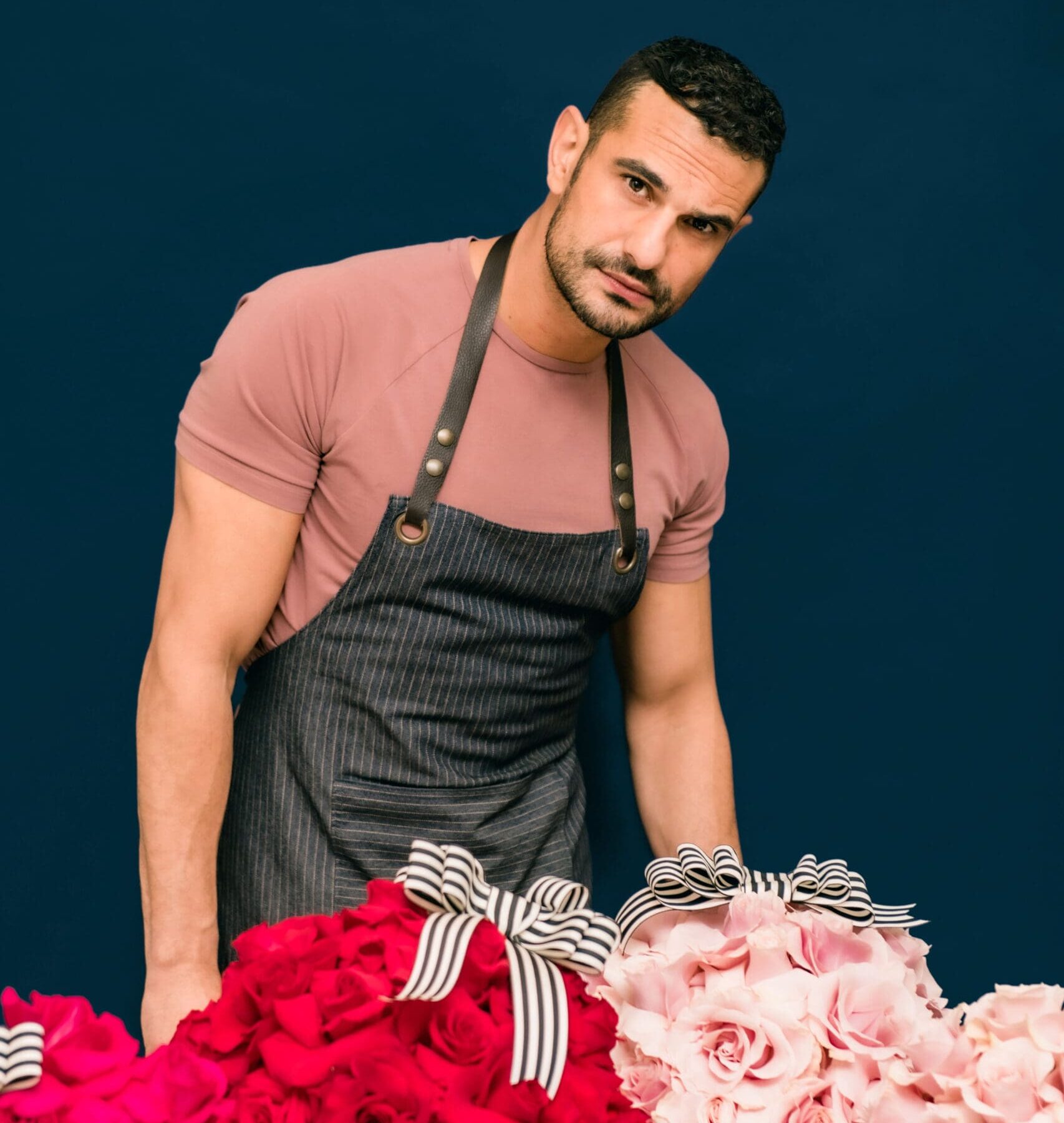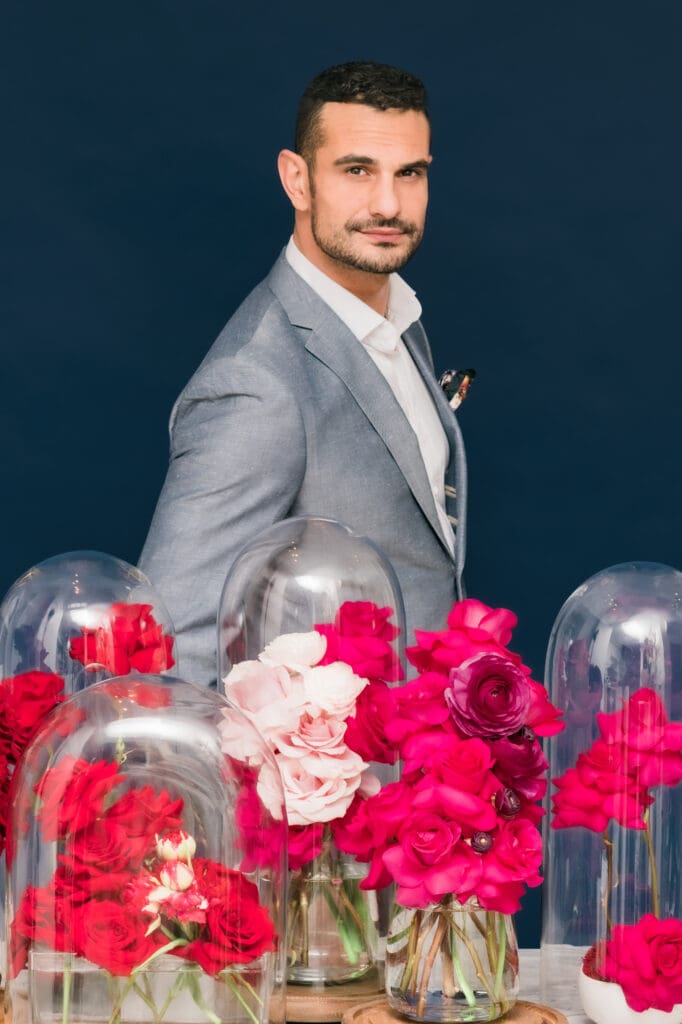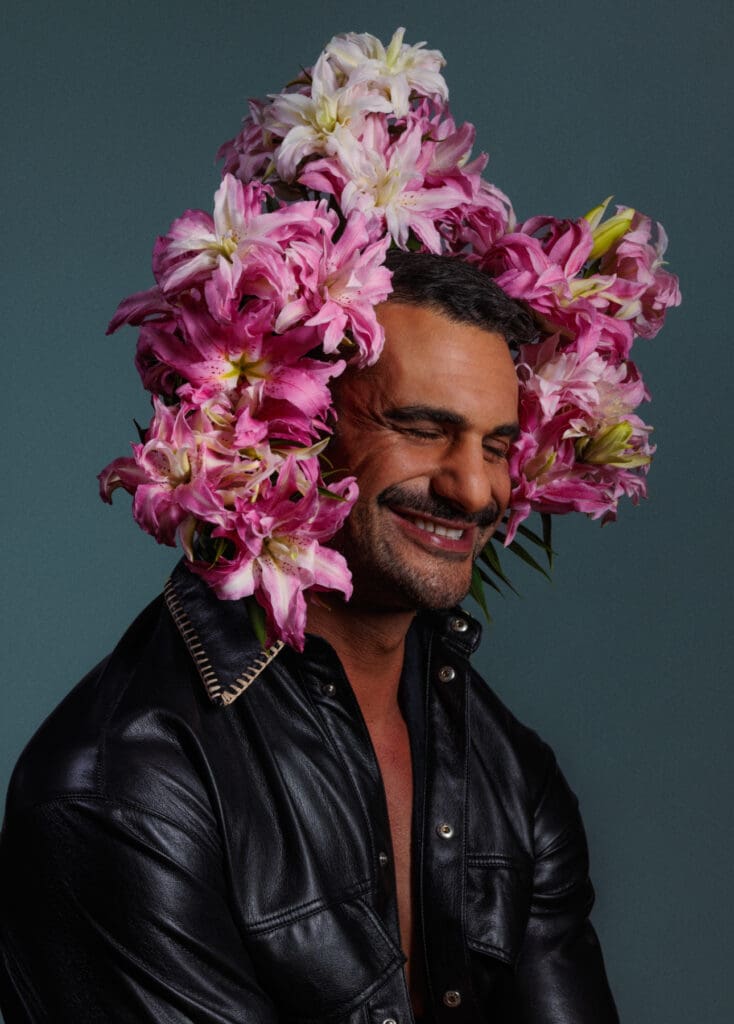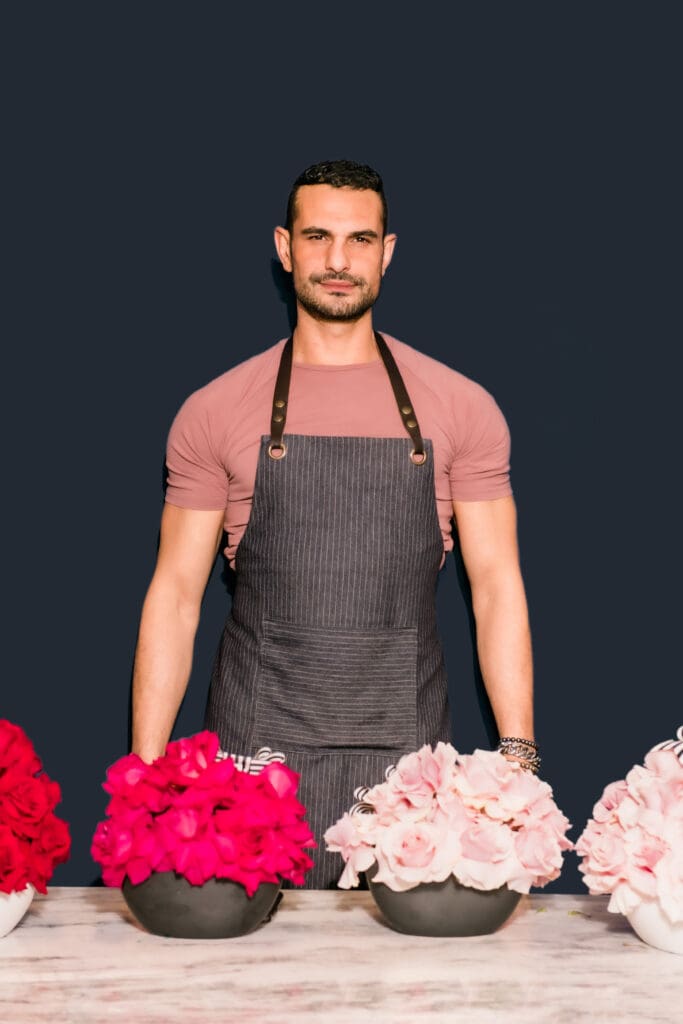From stunning sweet tables to jaw-dropping interiors, Caspar Haydar is a creative force transforming Toronto’s lifestyle and event scene. As the founder of Caspar Haydar Design and a familiar face from SUGARSTARS on The Food Network, this Australian native brings a love for florals, fashion and food to every project. We caught up with Caspar to talk design inspiration, high-profile clientele and the magic behind his one-of-a-kind creations. —Noa Nichol
Can you tell us how your background in fashion and premier nightlife venues influenced your approach to event design and floral installations?
My journey into event design has been shaped by two major influences: fashion and nightlife. Fashion instilled in me an appreciation for artistry, detail, and storytelling—the ability to craft something visually striking that evokes emotion, mood, and atmosphere. Every great piece of fashion tells a story, and I bring that same philosophy to my event designs.
Nightlife, on the other hand, gave me an entirely different skill set—the power of atmosphere, lighting, and transformation. A venue can shift from ordinary to extraordinary with the right design choices. Nightlife is about energy, emotion, and creating an experience that lingers in people’s memories long after the night is over—just like a beautifully designed event. It’s not just about aesthetics; it’s about how a space feels.
One of the biggest lessons from nightlife? Timing and adaptability. You learn to work with fast turnarounds, tight spaces, and ever-changing dynamics, which makes you resourceful, detail-oriented, and quick-thinking. And, of course, you learn how to stretch a budget without compromising the impact—which is a skill that has served me well in all areas of event design.
How has your experience on shows like Sugar Stars and I Do, Redo shaped your perspective on creating memorable and visually stunning events?
Being on Sugar Stars and I Do, Redo was a game-changer. Designing in a high-pressure, time-sensitive environment where everything had to be flawless on camera forced me to think differently about scale, impact, and storytelling.
On Sugar Stars, we were constantly challenged to push boundaries—creating showstopping cake displays, décor, and floral installations that were not just beautiful but also captivated an audience, whether in person or through a screen. It sharpened my ability to blend creativity with logistics, ensuring that every detail was both visually powerful and structurally sound.
I Do, Redo was very special because it wasn’t just about aesthetics; it was about emotion. These were couples who had overcome challenges, and we were helping them create a wedding that truly reflected their journey. It made me approach design with even more intention—it wasn’t just about beauty but about crafting deeply personal, meaningful experiences.
One of the biggest takeaways from TV? Everything has to be larger than life. The camera picks up every detail, so I learned how to make sure every installation had impact from every angle—a skill that translates seamlessly into real-world event design.
Your work blends impeccable taste with flawless execution. How do you balance creativity and practicality in your event designs?
For me, creativity and practicality go hand in hand. An event can be visually stunning, but if it’s not functional, immersive, or executed seamlessly, it loses its magic.
I always start by listening—really understanding my clients, their vision, and what they want to feel when they step into the space. From there, I focus on bringing that vision to life in a way that makes sense logistically—from flow and structure to how the design interacts with the environment.
A big part of my process is working with limitations, not against them. Budget, venue constraints, tight deadlines—rather than seeing them as obstacles, I see them as challenges that spark creative problem-solving. Some of my best designs have come from figuring out how to make something extraordinary within real-world constraints.
At the end of the day, the goal is to create an experience that looks effortless but feels unforgettable.
You’ve worked with some incredible brands and personalities, from Jessica Alba to Louis Vuitton. How do you approach designing for such diverse and prestigious clients?
Designing for global brands and high-profile personalities requires a balance of creativity, strategy, and discretion. Every client has a distinct identity, aesthetic, and set of expectations, so my approach is always highly customized.
For luxury brands like Louis Vuitton, I focus on respecting the brand’s legacy while bringing in fresh, innovative elements that align with their evolving identity. It’s about honoring their signature aesthetic but adding something that feels exclusive and experiential.
For personalities like Jessica Alba, it’s much more about creating an intimate, personalized atmosphere. Celebrities are constantly in the spotlight, so their events need to feel both aspirational and authentically them. It’s about understanding who they are, what makes them feel comfortable, and translating that into an experience that feels effortless but elevated.
Regardless of the client, my approach is the same: listen, research, and execute with precision.
What role do floral installations play in your events, and how do you ensure they become a signature element of your designs?
Floral installations are so much more than décor—they are storytelling elements. They set the tone, mood, and atmosphere of an event in a way that no other design element can.
For me, florals are about movement and emotion. I don’t just place flowers; I create sculptures, living installations that transform a space. Whether it’s a dramatic ceiling installation, a lush floral runway, or a delicate tablescape, the goal is always to make florals feel integrated into the space rather than just placed in it.
I also love unexpected contrasts—pairing delicate blooms with structural elements, or using unexpected color palettes that add depth and intrigue. Every floral design should feel intentional, immersive, and transportive.
Your work involves close collaboration with clients and event planners. Can you walk us through how you turn a client’s vision into reality?
Bringing a client’s vision to life starts with understanding their story, preferences, and desired atmosphere. I begin by listening intently—diving into their inspirations, style, and expectations for the event. From there, I work hand-in-hand with clients, agencies, and planners to fine-tune the practical aspects, such as timelines, venue logistics, and budget considerations.
Once we establish a clear direction, I move into the design phase, carefully selecting florals, décor, textures, and spatial elements that enhance the experience and align with the overall concept. Flexibility and adaptability are key throughout the process—adjustments are made along the way to ensure everything feels cohesive and surpasses expectations.
Ultimately, my goal is to create an event that feels effortless yet unforgettable, seamlessly blending personalization, creativity, and execution to reflect the client’s unique vision.
Having designed events in cities like Los Angeles, New York, and Sydney, how do regional aesthetics and cultures influence your work?
Each city has a distinct energy, cultural influence, and visual identity, which plays a significant role in shaping my design approach.
- Los Angeles inspires me with its effortless luxury and natural elements—I often incorporate organic textures, soft palettes, and warm lighting to reflect the city’s laid-back yet glamorous vibe.
- New York demands a bold, structured, and high-impact aesthetic—whether through modern statement pieces, architectural floral installations, or sleek, monochromatic palettes that resonate with its urban sophistication.
- Sydney has a unique mix of coastal relaxation and refined elegance. I love integrating vibrant hues, airy textures, and tropical influences to capture its sun-soaked energy while maintaining an elevated aesthetic.
Adapting my designs to reflect local aesthetics while maintaining my signature style is key. It’s about ensuring the event feels authentic to its surroundings, yet still brings something unexpected and memorable to the space.
What trends do you see shaping the future of event design, and how do you stay ahead of them?
One of the biggest shifts in event design is the increasing focus on sustainability. Clients are prioritizing eco-conscious choices, from biodegradable florals to reusable and repurposed décor that reduce waste without compromising luxury.
Another major trend is the rise of immersive, multi-sensory experiences—where lighting, sound, fragrance, and interactive elements work together to create a fully engaging atmosphere. The goal is to make guests feel like they’ve stepped into another world.
Additionally, oversized, life-sized props and installations are making a strong comeback. These large-scale, statement pieces transform venues into experiential spaces, offering not only visual impact but also highly shareable, Instagram-worthy moments.
To stay ahead of these trends, I constantly explore emerging materials, attend global design exhibitions, and collaborate with industry leaders. The key is to balance innovation with timeless aesthetics, ensuring that every event feels fresh yet enduringly elegant.
What has been the most challenging event or project you’ve worked on, and how did you overcome those obstacles?
Some of my biggest challenges come from working in heritage-listed buildings. These spaces are architecturally stunning but come with strict limitations—no drilling, no heavy installations, limited access points.
One event required us to suspend a massive floral canopy in a venue where we couldn’t attach anything to the ceiling. Instead of seeing it as a limitation, I approached it as a puzzle—how do we create this illusion of floating florals without damaging the space? We ended up designing a completely freestanding structure that blended seamlessly into the venue, giving the effect we wanted without breaking a single rule.
It was a challenge, but challenges fuel creativity, and the end result was breathtaking.
Advice for Aspiring Designers: For those looking to break into the world of event and floral design, what advice would you give about building a unique style and reputation?
- Find your voice. Your style is your signature—own it, refine it, and don’t dilute it trying to follow trends.
- Take risks. The best designs come from bold ideas and pushing boundaries. Don’t be afraid to experiment.
- Master logistics. Creativity is nothing without execution—understanding timelines, budgets, and operations is just as important as having great ideas.
- Build relationships. The industry is built on collaboration—nurture strong connections with clients, vendors, and creative partners.
- Never stop learning. Stay ahead of trends, technology, and materials—the best designers are always evolving.
The biggest lesson? If you’re passionate about it, people will see that passion in your work.




Be the first to comment